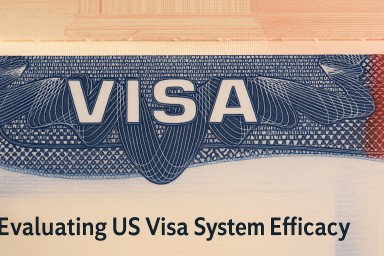US Visa Policies for Indian Applicants Explained
WEB'S ON FIRE
Chaifry
8/26/20253 min read


For many Indians, the US visa process feels like cracking a tough exam with no guarantee of passing. It’s a complex system balancing security, economic growth, and cultural exchange, managed by the US Department of State and Citizenship and Immigration Services. Visas are split into two types: temporary for short stays and permanent for settling down. But how well do these rules work for applicants filling forms, waiting anxiously, and chasing dreams? Let’s break it down, looking at temporary visas, permanent ones, shared challenges, and ideas to improve, keeping it simple and straight.
Temporary Visas: Short Stays, Specific Goals
Temporary, or nonimmigrant, visas let people with homes elsewhere visit the US for travel, work, or study. Labelled with letters like B for tourists or H for workers, they keep global ideas flowing, helping businesses and universities. They issue millions yearly, but the process isn’t always smooth.
A big strength is economic and cultural gain. The H-1B visa, popular among Indian engineers and doctors, fills skill gaps in tech and healthcare, sparking innovation. Companies depend on these workers for software and more. A yearly cap of 85,000 aims to protect local jobs, though enforcement gets flak. The Visa Waiver Program lets some skip visas for quick trips, boosting tourism spending. F-1 student visas bring billions through fees and living costs, letting young Indians study at top colleges and work briefly after. J-1 exchange programs for scholars or teachers share knowledge, enriching everyone.
But there are headaches. Interviews in busy spots like Mumbai can take months or over a year. From September 2025, most need in-person checks, slowing things down for safety’s sake. H-1B’s lottery means only a few qualified applicants win. Some firms cheat with multiple entries, hurting honest ones. Workers, especially in H-2A farm jobs, might face low pay or rough conditions. If your country’s flagged as risky, applications get extra scrutiny or rejections, feeling unfair. North American workers under trade deals have it easier, but job options are narrow. These visas attract talent, but delays and doubts frustrate. Saving for fees only to wait endlessly is a letdown.
Permanent Visas: Building a Life in the US
Permanent visas, leading to green cards, allow living and working freely, with paths to citizenship. Options include family ties, jobs, a lottery, or escaping danger. They build diverse communities, letting newcomers start businesses or pay taxes.
Family-based visas unite loved ones. Spouses or close kin of citizens face no caps, making it faster, resonating with our Indian value of togetherness. Distant relatives like siblings wait years due to limits, straining bonds. Job-based visas reward skill. Top-tier ones for geniuses like award-winning scientists move quickly. Others for degree-holders or investors creating jobs need big money but boost the economy. The diversity lottery picks from low-immigration countries, adding variety. Refugees or abused youth find safety.
These policies drive growth. Immigrants launch firms, innovate in tech, and fill healthcare or construction gaps. They add wealth, not drain it. But backlogs are a killer. Indians face decades-long waits due to per-country caps, like a queue stuck forever. Family separations hurt emotionally, and skilled workers may leave for places like Canada. Fraud in investments or fake marriages breeds mistrust.
Shared Challenges Across Both
Both visa types face delays. Renewals at consulates can lag months, potentially hurting events like global sports where fans might skip travel. Immigrants fuel jobs and culture with new foods and festivals, but some worry about resource strain or misuse like overstaying or undercutting wages. Employers sometimes use temporary visas for cheap labour, not real shortages. Chain migration, where one person brings many relatives, swells numbers. Stricter 2025 checks, like social media scans or country bans, aim for safety but may deter good applicants. Shifting rules between administrations confuse things. Fees, from hundreds to thousands, plus travel, hit hard. Weak English or limited appeals add barriers.
Ideas to Improve
Speed things up with more staff or online systems. Allow in-US renewals to save time. Audit employers to stop misuse. Adjust country caps for fairness. Use tech to catch fraud without delays. Balance security with openness, avoiding broad bans. More consulates in India, consistent officer training, and clear rule guides could help.
US visa policies grow wealth and diversity but stumble on speed and fairness. For Indian applicants, it’s a path of hope mixed with hurdles. With millions shaping the US, the system needs updates. Quick, fair decisions could keep it a magnet for dreamers. Got stories of your visa journey?
